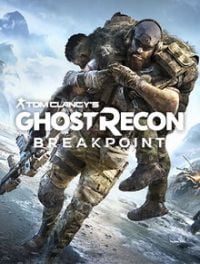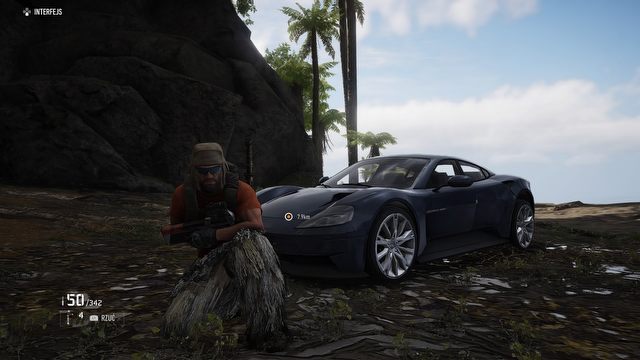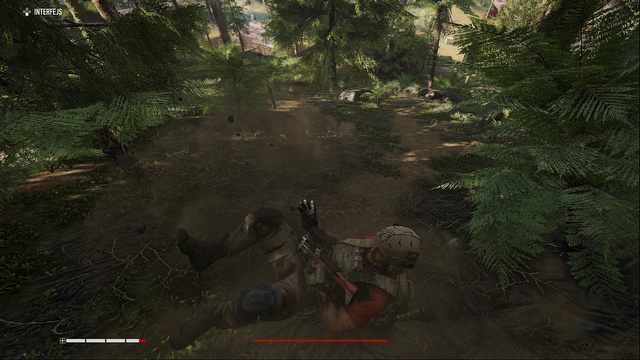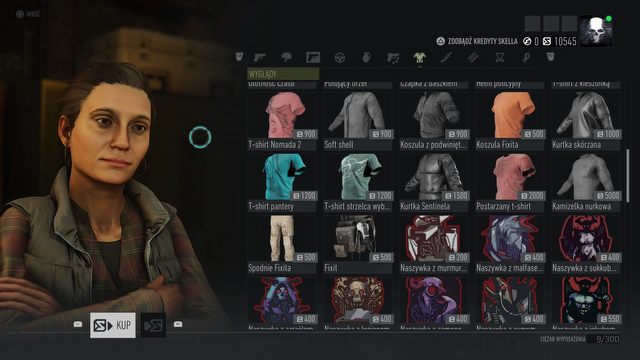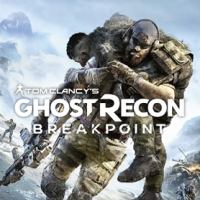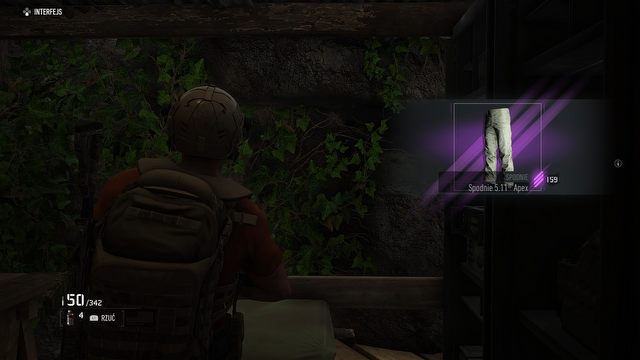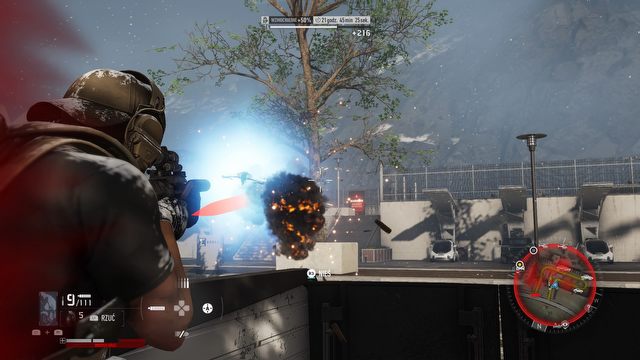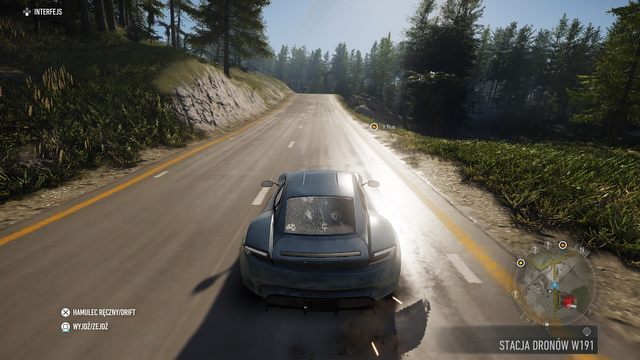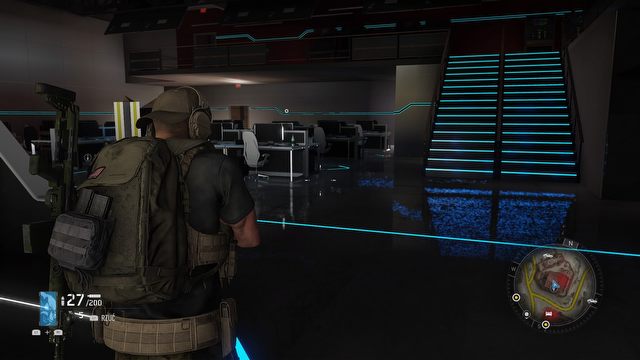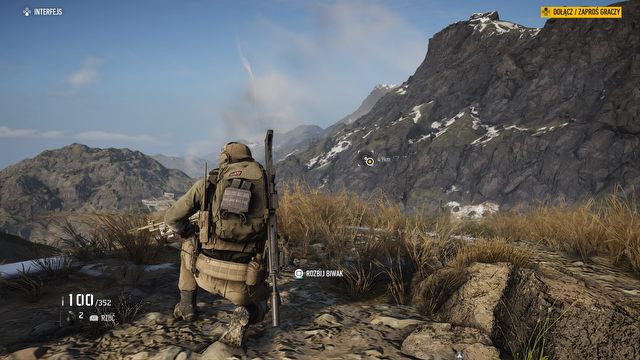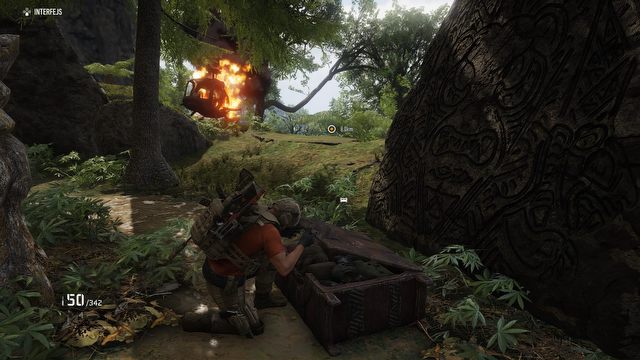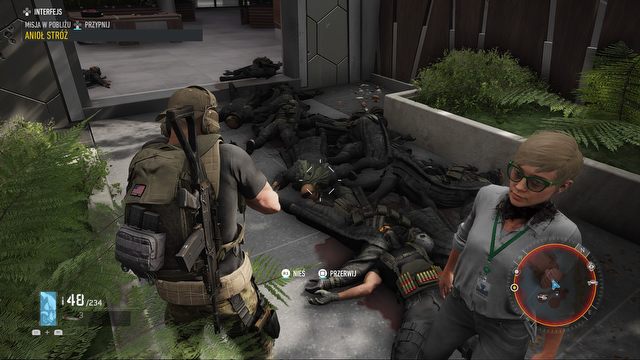Ghost Recon: Breakpoint Review – Even Anthem was More Compelling
Breakpoint is an unsuccessful, shapeless blend of ideas from all Ubisoft games. In the endless flood of virtual garbage to collect and buy, there was not even a trace of the cult Ghost Recon series.
The review is based on the PS4 version. It's also relevant to PC, XONE version(s).

- A good way to narrate the story that naturally evolves from start to finish, and has two interesting missions;
- you can complete all missions without any markers on the map: the dialogues and notes contain the necessary hints;
- if anyone's keen, there's a slew of activities to complete, and items to collect – every day;
- with the right team, you can take more tactical approach in the competition-oriented multiplayer.
- unnecessary, half-baked, and annoying looter-shooters mechanics;
- underwhelming combination of typical RPG with tactical shooting and survival;
- big, dead and empty world is not compelling at all;
- boring story with formulaic characters;
- highly exposed microtransactions with multiple elements available only for real cash;
- terrible driving model, especially of motorcycles;
- artificial intelligence of the enemies practically doesn't exist;
- many technical problems.
There is a story that the late writer Tom Clancy had a falling out with the creators of the game Splinter Cell over the fact that Sam Fisher's glasses could switch from NV to IR, which was actually unrealistic back then. What would the famous author say today about a game signed with his name, set in a fictional country, where space tanks can dodge to the side with speed that would certainly give the crew a whiplash, and frag grenades are made from pepper seeds?
The beginning of Ghost Recon: Breakpoint, however, is not so bad. There's a spectacular crash in enemy territory, and the main character – Nomad – barely survives it, which still gives hope for some cool, military survival. Unfortunately, all hope is lost right at the end of the prologue. We reach the main base with so much weapons and money that, when I went to the local bazaar, I immediately bought a sports supercar, an orange T-Shirt, two tattoos, and a fashionable hat. Nomad is certainly not the Rambo-style soldier, not a Bear-Grylls type of adventurer. What counts for him the most is money, and class... Or maybe just the former?
Ghost Recon: Breakpoint is a shapeless amalgam of all of Ubisoft's games and a few other productions, none of which have been properly thought through or polished. Compared to Ghost Recon: Wildlands, it's a step back in almost every meaningful way, and even if things are a little better here and there, there's always a “but." There's no solid story or interesting characters. It's a lousy tactical shooter, a weak RPG, a daft looter-shooter, and a sandbox set in a completely dead and artificial world. Breakpoint is basically a game revolving around endlessly collecting and clicking through the multitude of virtual garbage that's scattered on the map and found in as many as three stores in the game. Breakpoint sure as hell isn't Ghost Recon anymore.
Poor sequel to Wildlands
It's hard to even describe how very broken Breakpoint is in every point, how very incoherent its world is, how daft some of the ideas are. Examples? As a wounded spec-op, we're stranded on an island full of enemies – we don't know the area, and the first task I undertook (it admittedly was a side activity) was collecting ten sets of rusty screws for the local fisher. We engage in meaningless dialogues, looking at poorly made faces that are borderline Bethesda-RPG territory.
Wildlands vs. Breakpoint
Fans of the latest Ghost Recon: Wildlands will find a pretty similar formula of constant infiltrations of enemy bases in Breakpoint, but this time, if we do not play co-op, we'll always go it alone, without a virtual Ghost squad. This means that there are no mates that could revive you if things go fubar, and you'll have to begin the assault from scratch every time.
The loneliness of Breakpoint also took away the spectacular pursuits from Wildlands, where we would chase enemies with our companions raining fire from the back of the car. You can do that here, but only in coop – story missions simply don't have such sequences. The ubiquitous drones that can appear over our heads and alert others of our presence are a novelty. A good idea is the increase in size of urban areas, which brings more fighting indoors, which is nice, except some occasions when the position of the camera is a bit uncomfortable.
Although we do come to the rescue, the base is full of local refugees armed to the teeth with assault rifles, telling us they hate fighting and don't want us and our war at their home. The local vendor states that the settlement is poor and his offer is limited, after which we proceed to browse through eleven pages of his goods – must be an ambitious entrepreneur. His offer included, more than 40 cars, even though the island has practically no drivable roads, and the driving model resembles controlling a beach ball. High mountains and dense forests mean we're mostly using the heli to get to places, yet we'll end up rolling uncontrollably down the hills anyway – this feature of the physics engine is a definite highlight of the game.
In Ghost Recon: Wildlands we took part in a real war against drugs. Bolivia was like the real country – colorful and diverse. The roads were full of civilian cars. The local population lived in their villages, the guards played basketball and exercised, and our three Ghosts ensured assist and exciting chases even in single-player. Auroa in Breakpoint is completely extinct. The world consists almost exclusively of mountains and forests (like the map in Steep) with recycled assets of buildings. It is populated only by armed patrols and annoying drones. The only civilians outside the missions are the scientists in their labs, standing like trees or poring over computers as if a private army never invaded their land. The game world does absolutely nothing to create an atmosphere of any sort. This is a huge virtual sandbox, the only purpose of which is to give you some land to cover between solo missions, and hide a whole lot of redundant loot stashes.
Breakpoint works best in multi
If Breakpoint manages to generate any fun, it's in the multiplayer. Fast, 4 vs. 4 clashes, without the super-resilient drones require a much more tactical approach than any mission in the single campaign. The maps are well-designed – big enough to have some room to maneuver, but compact enough to make shootouts more than sporadic. Overall, the game is league above the new Modern Warfare, where the enemies are always on the opposite side, making it feel very "perpendicular."
Too bad there are so few modes, and that the latest one released for Wildlands, the Mercinaries, isn't here either. PvP works well, but you might want to make sure your entire team in 4v4 is able to communicate effectively. Tactical cooperation and constant communication is vital, otherwise, the combat will quickly turn chaotic and full of grief, because all mistakes the players make are very conspicuous.
Wannabie Destiny
Breakpoint is very much trying to pretend it's a looter-shooter similar to Destiny, but the core mechanics of this genre seemingly make absolutely no sense here. The implementation is even worse than in Far Cry: New Dawn. No matter what equipment you've got, any soldier can be killed with a single headshot. We constantly upgrade our equipment, but combat never really feels any different. Purple or yellow add-ons and bonuses change nothing at all. Still, you get a separate menu for customizing the character's looks and armor. You swap a kevlar helmet level 10 for a much better cap, level 15, and then you end up going everywhere in a cowboy hat that has no level at all – bizarre.
Each mission yields like 20 or 30 pieces of loot, but there's no way to sort it by level or label it as scrap. Clicking through all that every few dozen minutes to sell or disassemble it probably takes half the time spent in the game. You can just see the looter-shooter mechanics were implemented without any broader assumptions, without any particular end result in mind. It seems to be more about camouflaging the game's shortcomings with an illusion of progress and reward; about keeping the players busy with running from chest to chest, which is pretty engaging... for no more than 5 minutes.
The tactical survival marketplace
The constant changing of clothes and plundering the area doesn't really seem fit for a game about spec-ops, but Breakpoint in general forsakes tactical combat almost completely. Artificial intelligence works on the most primitive patterns, and the best strategy is usually finding a good piece of cover and taking down anyone who appears in the scope, and you can be sure they will, because the enemies seem rather mindless. If they don't get stuck somewhere, that is, for if they're not prevented by any of the other, numerous glitches and bugs. It's really hard to keep low profile, too – even in coop – because the enemies are aided by sci-fi robots, referred to as "drones" to confused the enemy. They serve as looter-shooter bullet sponges, and it's almost impossible to take them down quietly – bypassing them, on the other hand, takes ages. Given the length of the entire game, only the most persistent players should go with this approach.
The survival mechanics are also completely redundant. During missions, you will collect bags full of supplies – really, going for a mission sometimes feels like a walk to the grocery store, with the only difference you're getting shot at. A single chase through the forest can yield some honey, tomatoes, watermelons, kiwi, mushrooms, pumpkins, coconuts, fresh berries, pepper, bananas, all sorts of flowers, some screws, come scrap, a prickly pear, and yerba mate. Why all that stuff? In theory, it's required for crafting when camping at the bonfire not unlike some Lara Croft – C4, for example, is created from pepper seeds. However, since we can find ready-made explosives as well, and using foods from various sources doesn't really help to improve anything, crafting proves yet another element taken from other games without giving it too much thought.
Soldier – how much are you willing to give to save half a second?
Out of curiosity, I checked exactly how the reload speed changes when we consume food specially created for this purpose. I tested this with an LMG, which generally takes a while to reload. The time required to reload a weapon dropped from 6.5 seconds to 5.9 To craft the portion of food, we have to click through the camp menu a few times. The difference, however, is insignificant, and makes no real difference in a combat situation.
Misguided tour of Avroi
Perhaps the only element that was improved since Wildlands is the narration. We no longer feel like we're moving inside the same pattern over and over again with each new province. The story develops naturally, from beginning to end. There are more cut-scenes, more information about the world and the key characters. The side missions have also become much more complex, with their own story background and heroes. The devs deserve high praise for designing each quest so that it can be completed without referring to mission markers on the map. Each character or document tells us exactly where to look for the given place, what landmarks to look for, or which direction to go – and it really helps, provided we don't mind spending additional time in the game traveling.
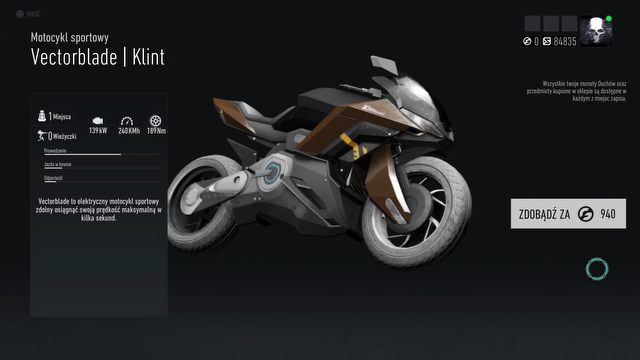
Many elements of equipment can only be purchased for real money. The value of all the items is something around $750.
But like I said – there's a "but." Better exposure of the story didn't make it interesting and compelling all of the sudden. It only slightly covers up the fact that all missions are nearly identical – clear the base, talk to the scientist, hack the computer. The story telling of a rebellious ex-soldier and his private army capturing an island with a factory of futuristic drones is just underwhelming and painfully boring. If someone has not watched Netflix' Punisher, they won't even notice the main villain in the game is performed by John Bernthal. He plays a typical tough guy, preaching hefty sermons and brimming with testosterone, which makes him totally indistinguishable from the rest of the cast.
Breakpoint also got a system of completely useless dialog options (look Anthem), and the mode without mission markers requires perusing dozens of notes and pictures, which the devs imaginatively defined as "investigations." All of these RPG elements were forced in here: unsubstantial character development included, all the elements are completely unfit in a game aspiring to be a tactical shooter. They just extend the boredom. It's also not clear from the gameplay whether the devs consulted their work with a military expert. The retrospections from a Middle Eastern war actually suggest the opposite – that the devs really missed this sort of guidance.
Cry and pay
If as much attention was paid to the RPG and looter-shooter mechanics as there was to creating the three, extensive stores in the game, things would be a whole lot better. Breakpoint became notorious for its aggressive micro-payments system even before the release, and the problem really does exist. There are hundreds of items that can be found in chests or bought for real money, and these are no cosmetics, but rather racing bikes that can't be found anywhere, or licensed backpacks from real manufacturers of outdoor equipment. The pricing of thing to buy for in-game currency is also weird. A big helicopter costs 40 thousand credits, and some inconspicuous sunglasses – 100 thousand.
Is Breakpoint a pay-to-win game?
It depends how you look at it. Breakpoint shares experience points and equipment across all modes, meaning that in MP, you can only use the gear you've obtained during single campaign, daily challenges, or multi-player games. Rifles have rather levelled stats, so that they don't unsettle the balance of MP games. Same goes for perks for each class.
Newbies joining the PvP without spending a lot of time in other modes won't have a big choices of scopes and weapons that players who invest real money have. However, it's enough to complete a few singe missions to get the basic equipment that allows competing with anyone on par. So, pay-to-win isn't really here, aprat from such extreme cases. With a regular approach, there is no cause for concern.
If you like to max games out, you have to be ready for lots of grind and mandatory micropayments – the premium currency not only makes purchasing faster, but is sometimes the only possibility. It would be understandable in a free-to-play game, but in a full-priced product focusing on coop is unfair. However, we end up paying for access to a store, where we can spend even more money. It doesn't matter how much time you spend playing – you'll only be able to watch the players who decided to spend money sport their premium items, without any chance to get them. And the devs made sure you will have plenty of chances to do just that, since matchmaking means mandatory visits to a hub that's sort of like the Destiny tower, where many players meet.
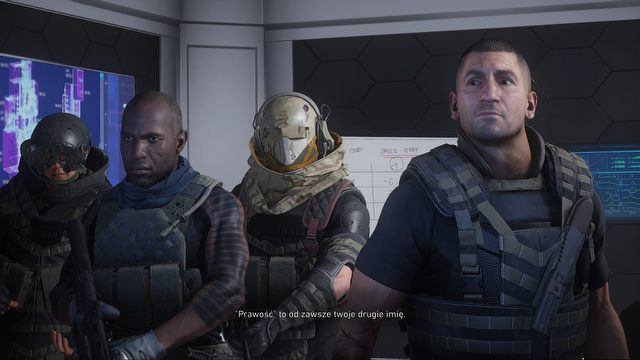
"Yep, we're in charge now! An ophthalmologist, a grim, a power ranger and Punisher!” The plot of Breakpoint is best quickly forgotten.
Nomad only for the stubborn
The appearance of the protagonist, Nomad, is also quite ridiculous. The store actually offers a skin that makes you look like the character we've seen in the game's promo materials in the web and TV (sic). You can also buy a figurine of the character – utterly bizarre.
It can only be unlocked after reaching level 49 of battle rewards for completing daily missions – getting there requires constant commitment over many days. It gets even more outrageous, when you consider there are daily limits for the amount of points you can get (sic) and that each level requires more points than the previous one, you might just get the idea of how long it takes to unlock the actual image of the protagonist of the game. And this is just bad – such a thing should be a reward for all the veterans of Wildlands (and every other player should be able to get it without so much fuss).
You can try to find your way around it, create a character that looks sort of similar and wait for Nomad's items to get to the store, but...
XXX
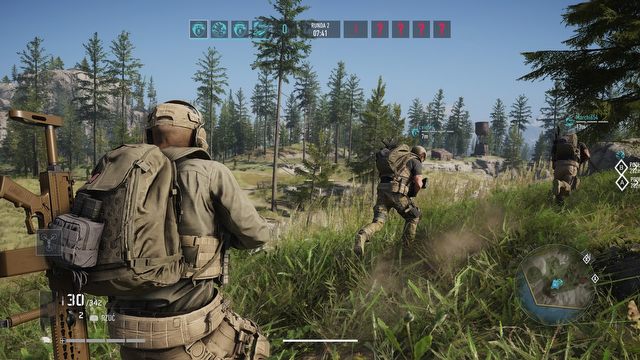
Multiplayer offers quite a few tactical clashes, provided your team communicates well – too bad there are so few modes.
I could write about errors, flawed graphics, strange camera position, the character obstructing the view, and the bobbing backpack giving me nausea, but I think that at this point, Breakpoint can't feel moire lackluster, even when we forget microtransactions. Instead of further refining the tactical shooting formula to match today's standards, the game has become a strange mix of genres dictated by one primary goal: to create a mega-game-service that you can work full-time in. Unfortunately, instead of a big sandbox with nice setting, where we could do almost anything we'd like, we got a playground where all the toys are broken.
So what that Breakpoint is huge, has nice views and 12 repetitive missions to complete every day, if the world has nothing substantial to offer, and the mechanics are pretty much all annoying across the board. This game is actually very similar to Sniper: Ghost Warrior 3, only the graphics are better. This game also served an underwhelming blend of mechanics from different games, and futuristic themes that totally didn't fit together. If you really want to play a spec-op, it's better to visit the magnificent Bolivia in Ghost Recon: Wildlands once again, where the machine guns always have the same power, where making the effort and getting good equipment will be enough for the whole game, and where your virtual pals can always help with sniper fire. Wildlands was the last Ghost Recon from this once fantastic series. Breakpoint is basically the first Ultimate Ubisoft Game – gaming full-time in a big world full of nothing.
ABOUT THE AUTHOR
With Ghost Recon (that hurt) Breakpoint I spent over 30 hours, completing the entire story and part of side quests and some multiplayer games. I rated the last intallment, Wildlands at 7.5, having disclaimed that the game deserves a point more if played in coop, and a point less if playing in single alone. I cannot see any mitigating circumstances for Breakpoint. It's as soulless and bland game both in multi and single-player. I've had much more fun with Far Cry: New Dawn, in which the ubiquitous "copy-pasting" at least had some utility, establishing a firm link with the prequel, and the game was short enough so that the residual RPG elements didn't have a chance to become annoying.
DISCLAIMER
We've received a review copy of Ghost Recon Breakpoint for free from Ubisoft – much appreciated.
Tom Clancy's Ghost Recon: Breakpoint
Ghost Recon: Breakpoint Review – Even Anthem was More Compelling
Breakpoint is an unsuccessful, shapeless blend of ideas from all Ubisoft games. In the endless flood of virtual garbage to collect and buy, there was not even a trace of the cult Ghost Recon series.
